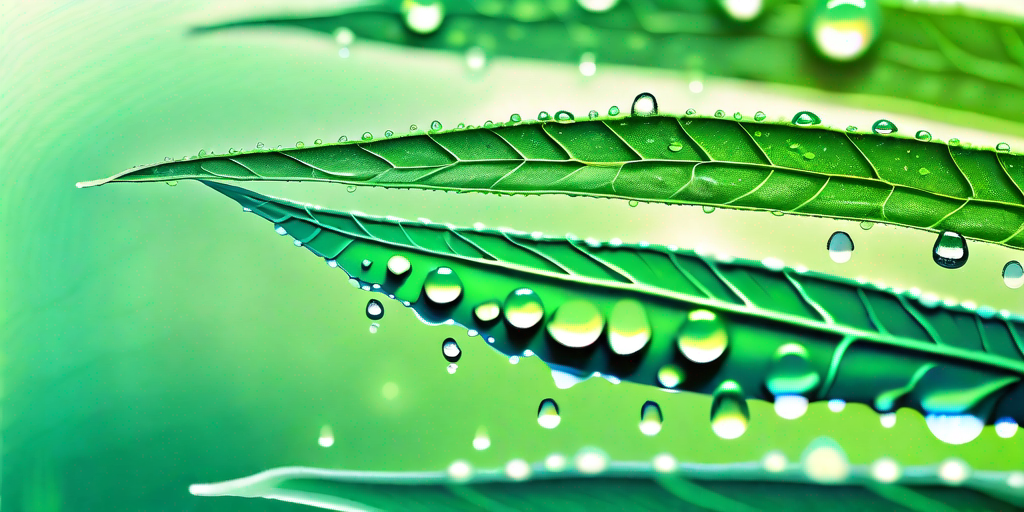
Welcome, dear reader, to the world of botany, where the plants have their own secrets and the trees whisper tales of mystery. Today, we're going to dive into one of nature's most captivating phenomena - guttation. It's not a new dance move or a fancy cocktail, but a process that plants use to exude excess water. Intrigued? Well, buckle up, because we're about to embark on a journey of discovery.
The Magic of Guttation: What Is It?
Let's start with the basics. Guttation is the process by which plants exude droplets of water from their leaves' edges. It's like the plant version of sweating, but without the unpleasant odor. This process usually happens at night or early in the morning when the plant's roots continue to absorb water from the soil, even when transpiration (the plant's equivalent of breathing) is low.
Now, you might be wondering, "Why do plants need to do this?" Well, it's all about balance. Just like humans, plants need to maintain a balance of fluids. When there's too much water intake and not enough transpiration, guttation comes to the rescue, helping the plant get rid of the excess water.
How Does Guttation Work?
Now that we've covered the 'what', let's move on to the 'how'. Guttation is a fascinating process, and it all starts with the plant's roots. These roots absorb water from the soil, which then travels up the plant through a network of tiny tubes called xylem. This process is driven by a force known as root pressure.
When the conditions are right, and the plant has absorbed more water than it can transpire, the excess water is forced out through special structures on the leaf edges called hydathodes. These hydathodes are like tiny faucets, releasing droplets of water that glisten in the morning light. It's a beautiful sight, and one that reveals the incredible complexity of nature.
Spotting Guttation in Action
So, how can you spot guttation in your own garden? Well, it's not as hard as you might think. The key is to get up early. Guttation usually occurs at night or in the early morning, so you'll need to be an early bird to catch this botanical phenomenon.
Look for small droplets of water on the edges of leaves. These droplets can be clear or they may have a white or yellowish color due to the presence of minerals or sugars. Plants that commonly exhibit guttation include strawberry plants, tomato plants, and some types of grass.
The Impact of Guttation on Plant Health
Now, you might be wondering, "Is guttation good or bad for plants?" Well, it's a bit of a mixed bag. On one hand, guttation can help plants maintain a balance of fluids, which is essential for their health. On the other hand, the process can also lead to the loss of valuable nutrients, which can impact the plant's growth and development.
Furthermore, guttation can sometimes lead to the spread of plant diseases. This is because the water droplets can contain bacteria or fungi, which can be spread to other plants. However, this is relatively rare, and in most cases, guttation is a normal and healthy part of a plant's life cycle.
Frequently Asked Questions about Guttation
1. Is guttation the same as dew?
No, guttation is not the same as dew. While both involve water droplets on leaves, the source of the water is different. Dew forms from atmospheric moisture, while guttation droplets are exuded from within the plant itself.
2. Can all plants exhibit guttation?
Not all plants exhibit guttation. The process is more common in plants that live in moist environments and have a high rate of water absorption.
3. Is guttation harmful to humans?
No, guttation is not harmful to humans. The water droplets exuded by plants are completely safe, although they may taste a bit salty due to the presence of minerals.
Final Thoughts
So there you have it, the fascinating phenomenon of guttation. It's a testament to the incredible complexity of nature and the amazing adaptations of plants. So the next time you're up early and spot those glistening droplets on the edges of leaves, take a moment to appreciate the magic of guttation. After all, it's not every day you get to witness a plant sweating!
And remember, in the world of botany, there's always more to learn. So keep exploring, keep asking questions, and keep discovering the secrets that plants have to offer. Who knows what you'll uncover next?















